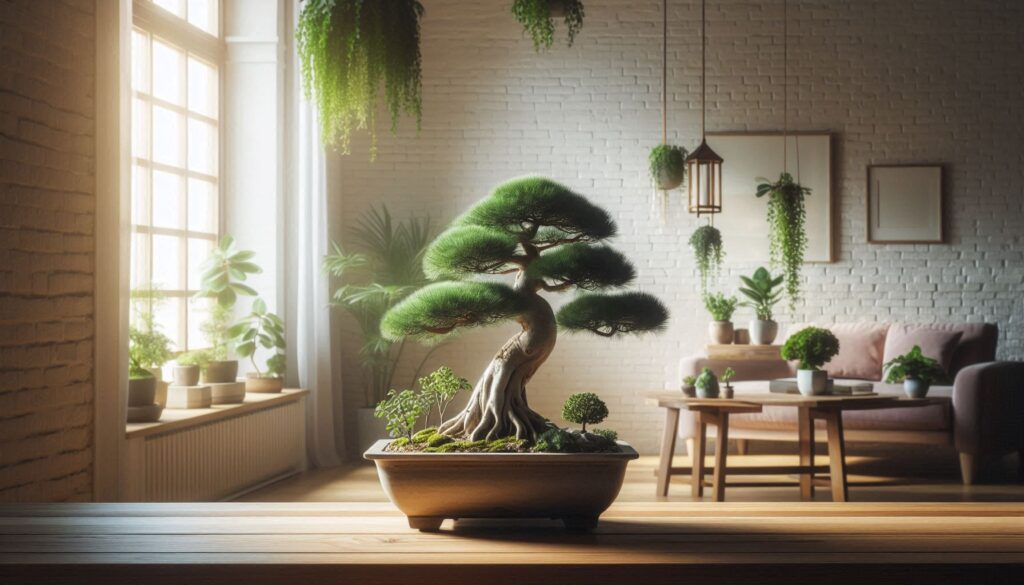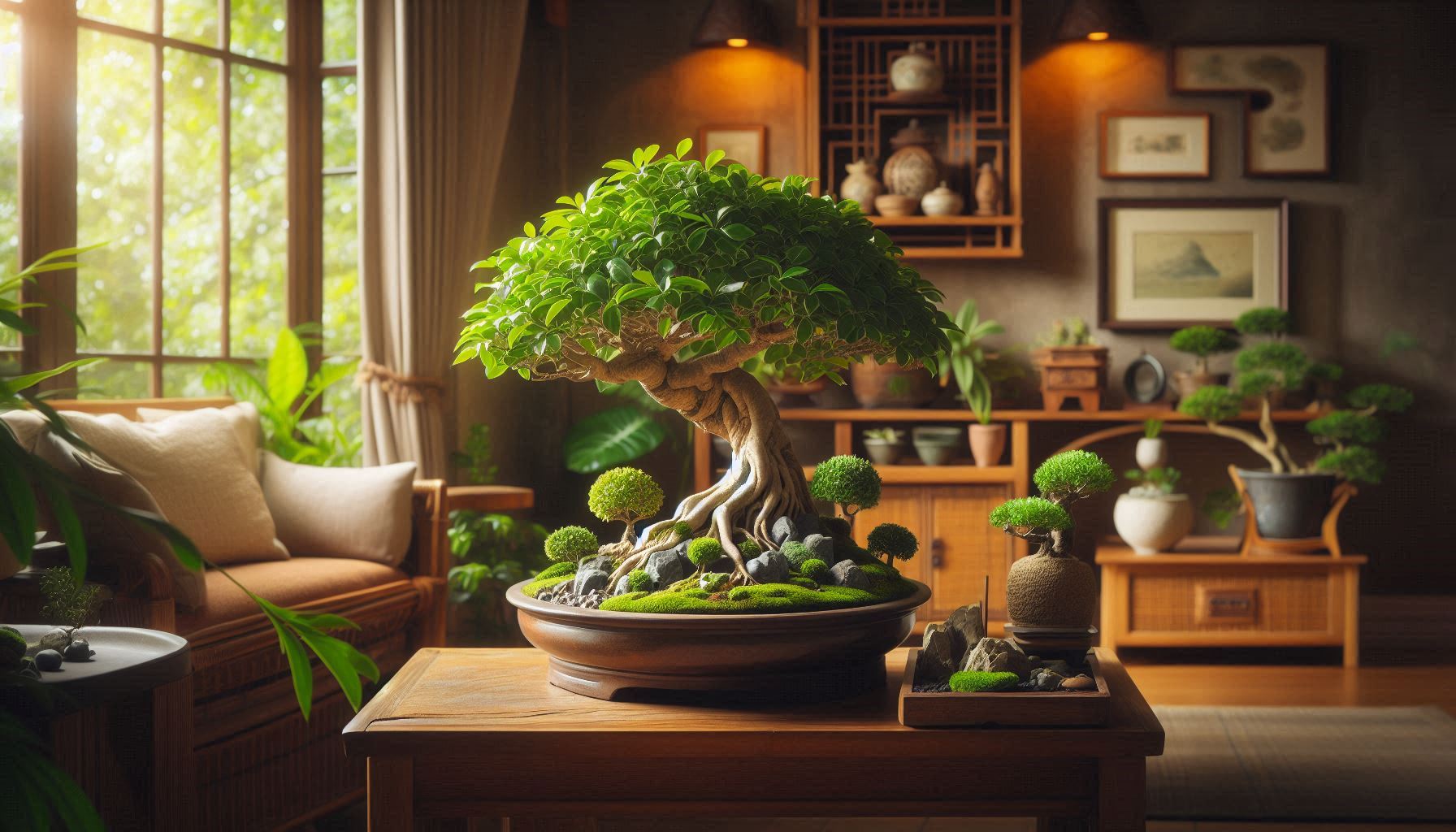In the realm of indoor gardening, few plants embody the artistry, patience, and serenity as effectively as bonsai trees. Originating from ancient Asian cultures, particularly Japan and China, bonsai cultivation has evolved into a worldwide hobby and art form that emphasizes the harmonious balance between nature and human intervention. Growing an indoor bonsai tree not only adds a touch of elegance and natural beauty to your living space but also offers a rewarding experience that encourages mindfulness, patience, and a deeper connection with nature.
What is Bonsai?
Bonsai, derived from the Japanese words “bon” (meaning tray) and “sai” (meaning planting), refers to the art of growing miniature trees in containers. The goal of bonsai cultivation is to create a scaled-down representation of a mature tree that exhibits the essential characteristics of its full-sized counterpart, such as a trunk, branches, and foliage, in a visually pleasing and harmonious composition.
Why Choose Indoor Bonsai Trees?
1. Aesthetic Appeal:
Indoor bonsai trees are admired for their natural beauty, intricate shapes, and artistic forms. They serve as living sculptures that enhance the visual appeal of any indoor space, from living rooms and offices to bedrooms and entryways.
2. Cultural and Historical Significance:
Bonsai has a rich cultural heritage rooted in ancient Asian traditions, where it symbolizes harmony, balance, and the essence of nature captured in miniature form. Growing indoor bonsai trees allows enthusiasts to appreciate and preserve this centuries-old art form.
3. Therapeutic Benefits:
Tending to an indoor bonsai tree promotes mindfulness and relaxation. The process of pruning, shaping, and caring for a bonsai encourages patience, focus, and a deeper connection with the natural world, making it an excellent hobby for reducing stress and promoting well-being.
4. Space-Saving Solution:
Indoor bonsai trees offer the opportunity to enjoy gardening and nature within limited indoor spaces. Their compact size and adaptability to indoor conditions make them suitable for apartments, condominiums, and urban dwellings where outdoor gardening space may be limited.
5. Educational Opportunity:
Growing indoor bonsai trees provides a hands-on learning experience about plant care, horticulture, and the principles of design and aesthetics. Enthusiasts can learn about different tree species, pruning techniques, and the cultural significance of bonsai through practical application.
Popular Indoor Bonsai Tree Species
When selecting an indoor bonsai tree, it’s essential to choose a species that thrives in indoor conditions and suits your climate and environment. Here are some popular indoor bonsai tree species:
1. Ficus (Ficus retusa or Ficus microcarpa):
Ficus bonsai trees are prized for their glossy leaves and tolerance to indoor conditions. They prefer bright, indirect light and moderate humidity. Ficus trees are versatile and forgiving, making them suitable for beginners.
2. Chinese Elm (Ulmus parvifolia):
Chinese Elm bonsai trees feature small, serrated leaves and a rugged bark texture that adds character to their appearance. They tolerate a wide range of indoor conditions and can be trained into various bonsai styles.
3. Jade Tree (Crassula ovata):
Jade trees are succulent bonsai trees with thick, oval-shaped leaves and a robust, tree-like appearance. They are drought-tolerant and prefer bright light. Jade trees are popular for their ease of care and resilience.
4. Japanese Maple (Acer palmatum):
Japanese Maple bonsai trees are prized for their delicate, palmate leaves that change color with the seasons. They require bright, indirect light and consistent moisture. Japanese Maples are favored for their ornamental value and seasonal interest.
5. Juniper (Juniperus spp.):
Juniper bonsai trees exhibit rugged, twisted trunks and needle-like foliage that resembles miniature evergreen trees. They thrive in bright light and appreciate cool temperatures. Junipers are valued for their resilience and classic bonsai aesthetics.
Essential Care Tips for Indoor Bonsai Trees
1. Lighting Requirements:
Place your indoor bonsai tree in a location that receives bright, indirect light for at least 4-6 hours daily. Rotate the tree periodically to ensure even light exposure and balanced growth.
2. Temperature and Humidity:
Most indoor bonsai trees prefer moderate temperatures between 60-75°F (15-24°C) and moderate humidity levels. Protect them from drafts and sudden temperature fluctuations, especially during winter.
3. Watering:
Water your indoor bonsai tree thoroughly when the top inch of soil feels dry. Use room temperature water and ensure that excess water drains freely from the bottom of the pot to prevent waterlogging.
4. Soil and Potting:
Use well-draining bonsai soil or a mix of akadama, pumice, and lava rock to promote healthy root growth. Repot your bonsai tree every 1-2 years to refresh the soil and encourage root development.
5. Pruning and Training:
Regular pruning is essential to maintain the shape and size of your indoor bonsai tree. Use sharp bonsai scissors or pruning shears to trim new growth and maintain the desired silhouette. Train your bonsai tree through wiring to create artistic forms and styles.
6. Fertilization:
Feed your indoor bonsai tree with a balanced, water-soluble fertilizer every 2-4 weeks during the growing season (spring to early autumn). Reduce fertilization during winter when growth slows down.
7. Pest Control:
Monitor your indoor bonsai tree for pests such as aphids, spider mites, or scale insects. Use organic pest control methods or insecticidal soap to treat infestations promptly.

Designing and Displaying Your Indoor Bonsai Tree
1. Choosing a Bonsai Style:
Select a bonsai style that complements the natural characteristics of your tree species, such as formal upright, informal upright, cascade, or windswept. Consider the tree’s trunk shape, branch structure, and overall balance.
2. Display Containers:
Choose a bonsai pot or container that complements your indoor decor and enhances the aesthetic appeal of your bonsai tree. Traditional bonsai pots are shallow and rectangular, but you can also use ceramic, clay, or handmade pottery containers.
3. Accentuating with Moss and Rocks:
Enhance the visual impact of your indoor bonsai tree by decorating the soil surface with moss, small rocks, or miniature figurines. These elements add texture and create a naturalistic setting for your bonsai display.
4. Creating a Bonsai Garden Display:
Arrange multiple indoor bonsai trees in a cohesive display to create a miniature bonsai garden. Use varying heights, textures, and foliage colors to achieve visual interest and balance.
5. Seasonal Themes and Decorations:
Celebrate seasonal changes by incorporating themed decorations into your bonsai display, such as miniature ornaments for winter or tiny blossoms for spring. These accents add charm and reflect the evolving beauty of nature.
Cultivating Joy and Tranquility
Growing indoor bonsai trees is more than a hobby; it’s a journey of patience, creativity, and appreciation for the natural world. Whether you’re a beginner or seasoned enthusiast, cultivating an indoor bonsai tree allows you to nurture a living work of art that brings beauty and serenity into your home. Through careful care and attention to detail, you can create a miniature landscape that captivates the senses and inspires a deeper connection with nature. Embrace the art of bonsai cultivation and embark on a rewarding journey that transforms your indoor space into a sanctuary of tranquility and natural beauty.

